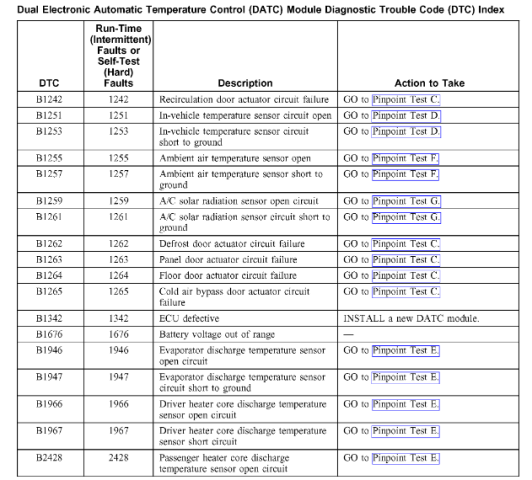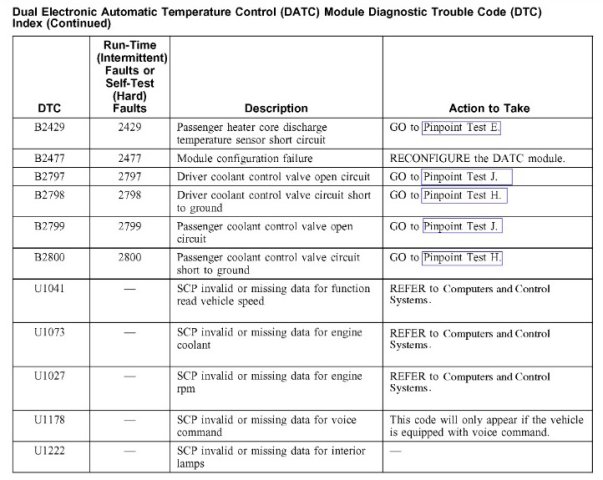The first thing you should do is an
A/C module diagnosis. There are 2 self-tests: On-demand Diagnostic Trouble Codes and Continuous Diagnostic Trouble Codes.
On-demand Diagnostic Trouble Codes
Front Panel Dual Automatic Temperature Control (
DATC) Module Self-Test (On-demand Diagnostic Trouble Codes — DTCs)
On-demand DTCs are those that are reported by an
ECU when a failure is detected while executing a diagnostic test. For the
DATC module this means that all faults (hard) that occur while the module is conducting a self-test shall be reported as an on-demand DTC.
The
DATC module self-test will not detect concerns associated with data link messages such as
engine coolant temperature or vehicle speed signals. A scan tool must be used to retrieve these concerns.
The vehicle interior temperature should be between 0-32°C (32-90°F) when carrying out the self-test. If the temperatures are not within the specified ranges, false temperature sensor DTCs may be displayed.
The
DATC module self-test through the front panel display can be initiated at any time. It is entered by pressing the OFF and DEFROST buttons simultaneously and then pressing the AUTO button within two seconds. Normal operation of the system stops when the self-test is activated.
The
DATC module reports individual on-demand DTCs as four-digit DTCs (less the alpha character). Record all DTCs displayed. Follow the diagnostics procedure given in the DTC index for each DTC given.
The
DATC module will calibrate all the mode doors and check all analog inputs. The
DATC module will only report on-demand (hard) faults that occurred while the
DATC module was conducting its self-test.
The
DATC module will light all control panel display segments if no faults are detected. The
DATC module will report individual on-demand DTCs without the °C symbol lit.
To exit the self-test, press any button. This will clear all on-demand codes from the
DATC module memory. If no button is pushed, DTCs will continue to be displayed.
Upon exit from the self-test the
DATC module returns to operational status. The
DATC module executes a hard (cold boot) reset which places the
DATC system in the OFF mode. Always exit the self-test before powering the system down (system turned OFF).
Continuous Diagnostic Trouble Codes
Front Panel
DATC Module Display — Retrieve Continuous Diagnostic Trouble Codes
Continuous DTCs are fault codes recorded by the
DATC module which have occurred during normal operation. For the
DATC module this means that all faults (intermittent or hard) that occur while the module is in an operational state shall be reported as a continuous DTC.
To retrieve continuous DTCs, press the OFF and DEFROST buttons simultaneously, followed by pressing the RECIRC button within two seconds.
The
DATC module will report all continuous DTCs to the vacuum fluorescent (VF) display. The
DATC module will not carry out a self-test; it will only display continuous faults codes which are stored in memory. All VF display segments will light if no faults are detected.
Individual continuous DTCs will be reported with the °C symbol lit. DTCs shall be reported as a four-digit DTC (less the alpha character).
Pressing the front defrost button will exit the retrieve continuous DTCs mode and clear all continuous DTCs from
DATC module memory.
Pressing any other button (other than DEFROST) will exit the retrieve continuous DTCs mode and maintain all continuous DTCs in
DATC module memory.
Upon exit from the retrieve continuous DTCs mode the
DATC module returns to operational status. The
DATC module executes a hard (cold boot) reset which places the
DATC system in the OFF mode.
doug7740
1955 Thunderbird Blue
View attachment 24039
View attachment 24040




